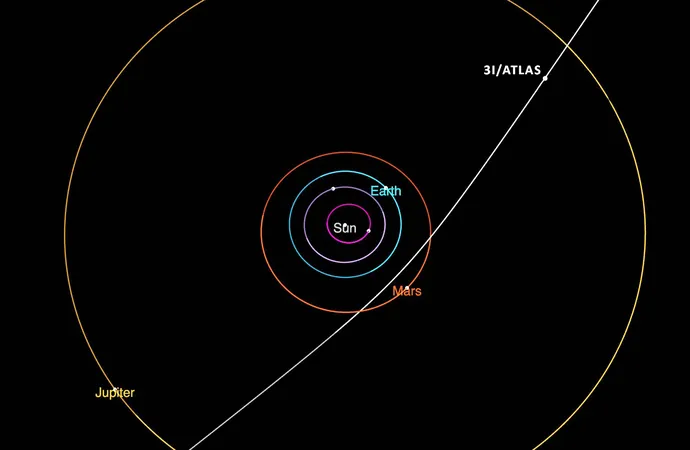
Astronomers Stunned by New Interstellar Object Zooming Past Earth
2025-07-09
Author: John Tan
A Shocking Discovery: Enter 3I/Atlas
Astronomers have just welcomed a fascinating new addition to the exclusive club of interstellar objects—say hello to 3I/Atlas! Officially recognized by the International Astronomical Union’s Minor Planet Center (MPC), this icy wanderer is making headlines for its astonishing size and staggering speed.
Speeding Through the Solar System
3I/Atlas is currently on a hyperbolic path that will send it hurtling back into interstellar space after a brief visit. Initial observations reveal a hazy comet-like appearance. Peter Veres, an astronomer who played a role in its confirmation, noted, "It looks kind of fuzzy," adding that there appears to be gas surrounding it, with some telescopes reporting a short tail.
An Icy Enigma
This peculiar halo forms when sunlight warms the comet’s surface, releasing dust and gas. Estimates suggest its nucleus measures between six to twelve miles (10 to 20 kilometers) across. However, its actual size may be smaller if the surface is particularly bright. Regardless, the most astounding attribute is its speed—over 60 kilometers per second (approximately 135,000 mph)! This remarkable velocity confirms that it cannot be captured by solar gravity, solidifying its status as a visitor from beyond our solar system.
A Global Effort to Spot the Interstellar Traveler
The exciting journey began at a telescope in Chile, part of NASA's ATLAS survey, which captured the rapid movement of 3I/Atlas on Tuesday. Astrophysicists from across the globe swiftly analyzed archival data, tracing its presence back to at least June 14. The calculations confirmed its hyperbolic orbit and its extraterrestrial origins.
No Danger, Just Wonder
European Space Agency's Richard Moissl reassures us that 3I/Atlas poses no threat to Earth or Mars as it zips through our solar neighborhood. It will reach its closest point to the Sun, known as perihelion, on October 29, after which it will fade from view as it retreats into the cosmos over the coming years.
Understanding the Interstellar Frontier
Interstellar objects differ significantly from those tethered to our Sun, originating instead from distant stars. Jonathan McDowell of the Harvard–Smithsonian Center for Astrophysics elaborates that these icy bodies are likely liberated from their home star systems as they drift through the galaxy.
Meet the Fastest Interstellar Comet Yet!
Following in the footsteps of its predecessors, 1I/'Oumuamua and 2I/Borisov, 3I/Atlas stands out as the largest and swiftest interstellar comet detected so far, providing scientists with a new specimen to scrutinize.
A Unique Observation Opportunity
Initially cataloged as A11pl3Z, the designation of 3I signifies its interstellar nature. As researchers gather more data, they aim to refine its orbit, rotation, and composition. They are particularly curious to see if its chemical composition differs from comets formed in our solar system, which could provide clues about its formation.
The Quest for Cosmic Knowledge
While a rendezvous with 3I/Atlas via spacecraft isn't feasible due to time constraints, ground-based and space telescopes will capture its light to analyze its chemical makeup. Observations continue as astronomers eagerly await insights into its composition and behavior.
The Future of Interstellar Discoveries
Mark Norris from the University of Central Lancashire highlights an exciting fact: models suggest there could be up to 10,000 interstellar objects drifting within our solar system at any time! New telescopes like the Vera C. Rubin Observatory promise to unveil even more of these cosmic travelers.
Embracing the Cosmic Wonders
As we prepare to observe 3I/Atlas during the northern autumn, scientists will delve into its chemistry and spin, while fine-tuning its orbit. Each discovery not only enriches our understanding of cosmic phenomena but also enhances our planetary defense strategies. In this fleeting moment, we get a glimpse of a cosmic snowball formed around a distant star, reminding us of the mysteries that await in the vast universe.



 Brasil (PT)
Brasil (PT)
 Canada (EN)
Canada (EN)
 Chile (ES)
Chile (ES)
 Česko (CS)
Česko (CS)
 대한민국 (KO)
대한민국 (KO)
 España (ES)
España (ES)
 France (FR)
France (FR)
 Hong Kong (EN)
Hong Kong (EN)
 Italia (IT)
Italia (IT)
 日本 (JA)
日本 (JA)
 Magyarország (HU)
Magyarország (HU)
 Norge (NO)
Norge (NO)
 Polska (PL)
Polska (PL)
 Schweiz (DE)
Schweiz (DE)
 Singapore (EN)
Singapore (EN)
 Sverige (SV)
Sverige (SV)
 Suomi (FI)
Suomi (FI)
 Türkiye (TR)
Türkiye (TR)
 الإمارات العربية المتحدة (AR)
الإمارات العربية المتحدة (AR)